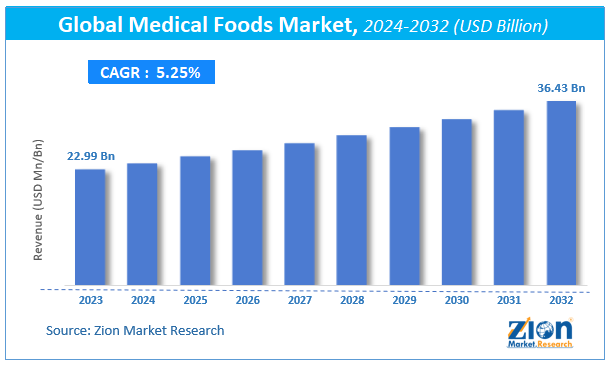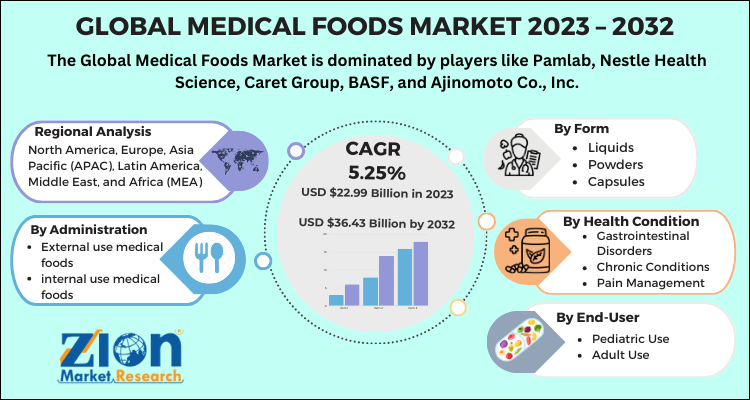Medical Foods Market Growth, Size, Share, Trends, and Forecast 2032

Medical Foods Market By Administration (External use medical foods and internal use medical foods), By End-user (pediatric use and adult use), By Form (liquids, powders, capsules, bars, and tablets), By Health condition (gastrointestinal disorders, chronic conditions, pain management, and psychological & neurological disorders) And By Region: - Global And Regional Industry Overview, Market Intelligence, Comprehensive Analysis, Historical Data, And Forecasts, 2024-2032
| Market Size in 2023 | Market Forecast in 2032 | Growth Rate (in %) | Base Year |
|---|---|---|---|
| USD 22.99 Billion | USD 36.43 Billion | CAGR at 5.25% | 2023 |
Description
According to the report published by Zion Market Research, the global Medical Foods Market size was valued at USD 22.99 Billion in 2023 and is predicted to reach USD 36.43 Billion by the end of 2032. The market is expected to grow with a CAGR of 5.25% during the forecast period. The report analyzes the global Medical Foods Market’s growth drivers, restraints, and impact on demand during the forecast period. It will also help navigate and explore the arising opportunities in the Medical Foods Market industry.
Global Medical Foods Market: Overview
In Global Medical Foods Market Report, Often confused with dietary supplements or nutraceuticals, medical foods are specially designed foodstuffs intended to cater to the distinct nutritional requirements of a patient suffering from a particular health condition and are to be administered only under the supervision of medical personnel. As a dietary management strategy, medical foods are those that are specially designed, formulated, and processed considering the patient’s needs as opposed to the naturally occurring foods that are recommended by physicians as part of the overall diet for the management of symptoms. The patient typically has an impaired or limited capacity to ingest, absorb, digest, or metabolize nutrients in ordinary food. In such situations, the modifications in diet do not suffice and therefore medical foods are necessary.
Global Medical Foods Market: Growth Factors
After the introduction of milk formula for infants known as Lofenalac, medical foods began to gain traction steadily to include a plethora of products for the treatment of disorders and illnesses associated with nutrition. These health conditions include cardiovascular disease, diabetes, osteoporosis, mitochondrial disease, Alzheimer’s disease, and inborn metabolism errors. The incidence of rare conditions such as motor neuron disease (MND) has been escalating. Because MND is an irreversible condition for which no treatment or drugs are available, the only alternative is to curb the progression of the disease. As medical foods can compensate for nutritional deficiencies that are responsible for the progression of such conditions, they are considered an ideal alternative to ordinary food.
Moreover, the health of numerous patients who are receiving treatment for chronic conditions is adversely affected by the drugs used in the treatment and often suffers from nutritional deficiencies. Medical foods are increasingly being recommended by healthcare practitioners including dieticians for overcoming these nutrient deficiencies, transforming the global medical foods market dynamics. For instance, bone health is restored by medical food consumption by improving bone mineralization since these foods contain zinc and vitamin D.
Before they are introduced in the market, medical foods require effective results from clinical trials along with approval from experts to ensure their safety. Therefore, the regulations and rules pertaining to the launch of new medical foods might hinder the growth of the medical foods market. However, the fact that patients do not require a prescription for buying medical foods can ensure increased sales.
Global Medical Foods Market: Segmentation
The global medical foods market can be segmented by the administration, end-user, form, health condition and region.
By the method of administration, external use medical foods and internal use medical foods are the two broad categories of the global medical foods market. The internal use of medical foods is likely to collect significant revenue over the forthcoming times. Several market players are introducing medical foods that have better taste and texture.
By end-user, the global medical foods market can be segmented by pediatric use and adult use. The adult use segment is expected to dominate the global medical foods market.
On the basis of form, the market can be classified into liquids, powders, capsules, bars, and tablets.
On the basis of health conditions, the key broad segments can be gastrointestinal disorders, chronic conditions, pain management, and psychological & neurological disorders. The chronic conditions segment presents considerable opportunities, owing to the alarming increase in patients suffering from diabetes and similar chronic conditions.
Medical Foods Market : Report Scope
| Report Attributes | Report Details |
|---|---|
| Report Name | Medical Foods Market Research Report |
| Market Size in 2023 | USD 22.99 Billion |
| Market Forecast in 2032 | USD 36.43 Billion |
| Growth Rate | CAGR of 5.25% |
| Number of Pages | 201 |
| Key Companies Covered | Pamlab, Nestle Health Science, Caret Group, BASF, and Ajinomoto Co., Inc. |
| Segments Covered | By Administration, By End-user, By Form, By Health condition and By Region |
| Regions Covered | North America, Europe, Asia Pacific (APAC), Latin America, Middle East, and Africa (MEA) |
| Base Year | 2023 |
| Historical Year | 2018 to 2022 |
| Forecast Year | 2024 - 2032 |
| Customization Scope | Avail customized purchase options to meet your exact research needs. Request For Customization |
Global Medical Foods Market: Regional Analysis
North American medical foods market is projected to account for the largest share in the total revenue of the global medical foods market, owing to increasing awareness regarding the benefits of medical foods, the growth in geriatric population, heavy investments in R&D initiatives, and beneficial government policies across countries such as Canada and the US.
Asia Pacific has also been demonstrating greater acceptance of medical foods. The increasing geriatric population, coupled with the significant increase in chronic ailments is contributing toward the market expansion. As the taste and texture of medical foods is improving, it is becoming more palatable than medical foods of the past. This might also lead to greater acceptability of medical foods across the region.
Global Medical Foods Market: Competitive Players
- Pamlab
- Nestle Health Science
- Caret Group
- BASF
- Ajinomoto Co., Inc.
are some noteworthy market players operating in the global medical foods market. Agreements, collaborations, mergers, and acquisitions are frequently being undertaken by a majority of medical foods manufacturers on a global scale.
The Global Medical Foods Market is segmented as follows:
By Administration
- External use medical foods
- internal use medical foods
By End-user
- pediatric use
- adult use
By Form
- liquids
- powders
- capsules
- bars
- tablets
By Health condition
- gastrointestinal disorders
- chronic conditions
- pain management
- psychological & neurological disorders
Global Medical Foods Market: Regional Segment Analysis
- North America
- The U.S.
- Canada
- Europe
- France
- The UK
- Spain
- Germany
- Italy
- Rest of Europe
- Asia Pacific
- China
- Japan
- India
- South Korea
- Southeast Asia
- Rest of Asia Pacific
- Latin America
- Brazil
- Mexico
- Rest of Latin America
- Middle East & Africa
- GCC
- South Africa
- Rest of Middle East & Africa
What Reports Provides
- Full in-depth analysis of the parent market
- Important changes in market dynamics
- Segmentation details of the market
- Former, ongoing, and projected market analysis in terms of volume and value
- Assessment of niche industry developments
- Market share analysis
- Key strategies of major players
- Emerging segments and regional markets
- Testimonials to companies in order to fortify their foothold in the market.
Table Of Content
HappyClients
Zion Market Research
Tel: +1 (302) 444-0166
USA/Canada Toll Free No.+1 (855) 465-4651
3rd Floor,
Mrunal Paradise, Opp Maharaja Hotel,
Pimple Gurav, Pune 411061,
Maharashtra, India
Phone No +91 7768 006 007, +91 7768 006 008
US OFFICE NO +1 (302) 444-0166
US/CAN TOLL FREE +1 (855) 465-4651
Email: sales@zionmarketresearch.com
We have secured system to process your transaction.
Our support available to help you 24 hours a day, five days a week.
Monday - Friday: 9AM - 6PM
Saturday - Sunday: Closed






